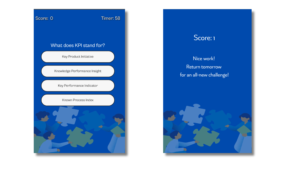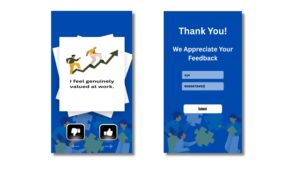Level Up Your Workplace: How Gamification Boosts Employee Engagement
“Your employees are your greatest asset.”
It’s more than a corporate cliché—it’s a strategic truth. Engaged employees drive innovation, productivity, and retention. But in today’s hybrid and fast-paced work environments, traditional engagement tactics often fall short.
Enter gamification: the art of applying game mechanics to non-game contexts. When done right, it transforms routine tasks into rewarding experiences, making work more interactive and enjoyable.

Why Employee Engagement Matters
Engaged employees are:
- 21% more profitable
- 41% less likely to be absent
- 17% more productive
These statistics, highlighted by Gallup, underscore the tangible benefits of fostering a motivated workforce.
The Power of Gamification in the Workplace
Gamification taps into intrinsic human desires: achievement, competition, and recognition. By integrating elements like points, badges, and leaderboards into daily tasks, companies can:
- Enhance motivation and productivity
- Encourage continuous learning
- Foster collaboration and healthy competition
- Provide real-time feedback and recognition
Playzo.io: Gamifying the Workplace
Experience
When we talk about employee engagement, we often think of surveys, all-hands meetings, and the occasional pizza party. But let’s be honest — those tactics don’t always move the needle anymore. Employees want to feel involved, challenged, and recognized — not just checked in on.
That’s where Playzo.io steps in.
Playzo.io offers interactive, customizable games built specifically for brands, HR teams, and L&D departments who want to level up engagement — without the friction of complex software or expensive internal development.
Let’s explore how Playzo.io can turn everyday moments into exciting opportunities to connect, learn, and grow.
1. Quiz Game – “Brain Battle of the Week”
Use Case:
Launch a weekly quiz challenge to test knowledge across departments — covering company policies, product updates, or even just fun general trivia.
Why It Works: (Preview)
- Reinforces Learning: Whether it’s onboarding or compliance, quizzes are a proven way to reinforce material.
- Leaderboard Dynamics: A little competition never hurts. Weekly scores and badges boost motivation and encourage repeated participation.
- Cross-Team Interaction: Let departments compete, or build mixed teams to increase collaboration and camaraderie.
Bonus Tips with Playzo.io:
- Randomize questions from a larger question bank to keep content fresh.
- Enable real-time leaderboards with playful sound effects or notifications.
- Offer weekly badges, certificates, or a simple leaderboard shoutout in internal newsletters.
Real Impact:
Companies using quiz-based learning tools have seen a 25–50% improvement in training retention, especially when spaced repetition and gamified rewards are used (source: TalentLMS).

2. Poll Game – “Culture Check Pulse”
Use Case:
Replace boring HR surveys with interactive polls that feel more like Buzzfeed than bureaucracy.
Why It Works: (Preview)
- Better Participation: A visually engaging poll gets more attention than a dry Google Form.
- Honest Feedback: Anonymous responses ensure employees speak freely.
- Instant Insights: HR and leadership teams can use real-time data to understand sentiments and improve internal communication.
With Playzo:
- You can run instant sentiment polls after a town hall, policy change, or team outing.
- Customize branding, tone, and even the emoji options — keep it you, not corporate-speak.
- Collect feedback via QR codes, links in emails, or even inside your company Slack or WhatsApp group.
Stat to Know:
According to Qualtrics, organizations with frequent pulse checks experience 27% lower turnover and are 4.6x more likely to have engaged employees.

Real-World Success Stories in Employee Gamification
Let’s take a look at how leading companies have successfully used gamification to drive employee engagement, wellness, and motivation—with tangible results that go beyond participation metrics.
NextJump: Building a Culture of Wellness Through Gamified Fitness
About the Company:
NextJump is a U.S.-based technology company known for its employee-focused culture and workplace innovation. They operate loyalty programs and have a strong reputation for workplace experimentation—especially around employee development and well-being.
What They Did:
- NextJump introduced a wellness initiative centered on two gamified tools:
- FitRank: A live leaderboard tracking physical activity among employees.
- WOWPoints: A virtual currency awarded for healthy behaviors like regular exercise, which could be redeemed for real-world rewards such as merchandise or gift cards.
- They made exercise part of their culture, encouraging team-based workouts and peer accountability. The leaderboard created a sense of healthy competition, while WOWPoints offered tangible motivation.
Results:
- Employee exercise participation increased from 5% to over 80%.
- A noticeable boost in energy, collaboration, and morale was observed.
- The program became a core part of the onboarding and employee culture, with new hires encouraged to join workout squads.
Why It Worked:
- It integrated fun and competition without pressure.
- Rewards were meaningful and tied to wellness.
- Progress was visible, trackable, and celebrated.
Kaupmees & KO: Celebrating 30 Years with Games That Unite
About the Company:
Kaupmees & KO is one of the largest wholesale distributors in Estonia, with hundreds of employees and a wide operational footprint. For their 30th anniversary, they wanted to do something special—beyond the typical speeches and banquets.
What They Did:
- The company launched a gamified internal campaign using Adact’s platform, which allowed them to:
- Run a multilingual digital game accessible to all employees.
- Offer fun and educational content about the company’s history and values.
- Include a leaderboard and mini-rewards to boost participation.
Results:
- Over 66% of employees participated in the game voluntarily.
- Engagement levels remained high throughout the campaign, with teams discussing results and scores actively.
- Strengthened cross-department bonding and instilled a renewed sense of company pride.
Why It Worked:
- The campaign was celebratory, not instructional.
- It made every employee feel part of a milestone.
- It was inclusive, simple to access, and culturally relevant.
Thrive: Rewarding Health with Wearable-Driven Challenges
About the Company:
Thrive is a UK-based health-tech firm focused on employee wellness. They offer workplace mental health support and digital tools for mindfulness and behavioral therapy.
What They Did:
Thrive introduced a gamified wellness program using wearable devices (like Fitbits) to encourage healthy daily habits among employees:
- Steps walked, hours slept, and mindfulness sessions were tracked.
- Employees earned points for hitting daily and weekly goals.
- Leaderboards and wellness “streaks” were used to encourage friendly competition.
Results:
- Participation levels rose steadily to over 70% of staff.
- Internal health surveys reported a 30% improvement in perceived well-being.
- Company saw lower absenteeism rates and higher employee satisfaction.
Why It Worked:
- Gamification was tied to personal wellness goals, not just productivity.
- Employees saw direct benefits like energy, better sleep, and stress relief.
- Progress was visualized and rewarded, tapping into long-term motivation.
Implementing Gamification: Best Practices
- Set Clear Objectives: Define what you aim to achieve—be it increased productivity, enhanced learning, or improved collaboration.
- Understand Your Audience: Tailor games to suit the preferences and needs of your employees.
- Ensure Voluntary Participation: Avoid making games mandatory to prevent resistance.
- Provide Meaningful Rewards: Recognize achievements with rewards that resonate with your team.
- Gather Feedback: Continuously seek input to refine and improve gamification strategies.
Frequently Asked Questions
Q1: Can gamification be applied in remote work settings?
A: Absolutely. Digital platforms like Playzo.io are designed to engage remote teams effectively.
Q2: How do we measure the success of gamification?
A: Monitor metrics such as participation rates, task completion times, and employee feedback.
Q3: Is gamification suitable for all industries?
A: While particularly effective in tech and customer service sectors, gamification can be adapted to various industries with the right approach.
Q4: What if employees don’t engage with the games?
A: It’s crucial to ensure that games are relevant, enjoyable, and offer meaningful rewards. Gathering feedback can help tailor the experience.
In Conclusion
Gamification is more than just a trend; it’s a powerful tool to enhance employee engagement. By integrating game elements into the workplace, companies can foster a more motivated, collaborative, and productive environment.
Ready to transform your employee engagement strategy? Explore Playzo.io and discover how gamification can revolutionize your workplace.